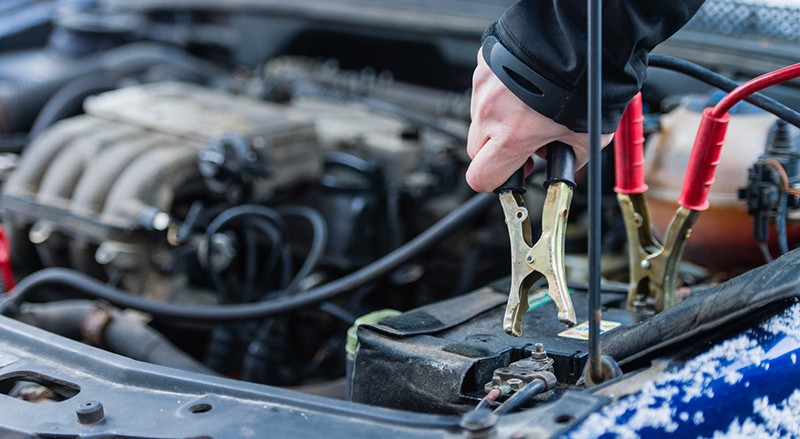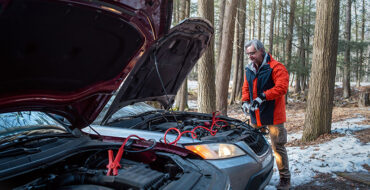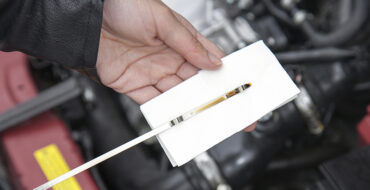A dead car battery is always an unwelcome surprise and one that can instantly throw off your day. This issue is especially common in winter, when the cold weather puts extra strain on your battery. But can you recharge your battery? Or is it time for a new one? We’ll walk you through the decision.
Can you recharge a dead car battery?

What causes a dead battery?
A car battery can die for many reasons. Something as simple as leaving the lights in your vehicle on too long or taking frequent short trips can drain it. Environmental causes such as extreme weather can reduce power output in your vehicle. Other causes include loose or corroded battery connections.
Proper maintenance can help prevent many of the issues that lead to a dead battery, but sometimes there’s nothing you can do. Thankfully, unless it’s severely damaged, recharging a battery is a straightforward fix.
Is your battery safe to recharge?
Inspecting your car battery for signs of damage before attempting a jump start is crucial. Wear gloves during this step.
First, look for visible cracks, leaks, or corrosion around the terminals. If you find any signs of damage, do not recharge the battery. Replace it instead to avoid potential hazards.
Should you, however, see some corrosion but the rest of the battery looks intact, clean it with battery cleaner and a battery terminal brush. Ensure cables are secured, and then proceed with the jump-start.
Is jump-starting a car battery the same as recharging it?
Charging a car battery involves three basic steps:
- The engine sends mechanical energy to the alternator.
- The alternator changes that energy into electrical energy and sends it to the battery.
- The battery stores that electricity and distributes it to your vehicle’s various electrical components.
Therefore, jump-starting and recharging a battery have different meanings:
Jump-starting means giving it a temporary boost of power so the engine can start.
Recharging means restoring its full charge so it can again perform essential functions.
How to perform a jump start
Properly jump-starting your car will allow you to safely assess the condition of the battery.
Step 1: Park a car with a working battery close to the vehicle with the dead battery. They should be close enough for the jumper cables to comfortably reach each battery without the vehicles touching.
Step 2: Shut off the car with the functional battery. Ensure both vehicles are in park or neutral with the parking brake engaged.
Step 3: Open the hood on both vehicles and locate their batteries. Use this opportunity to do a final inspection for damage, cracks, or corrosion that may need to be addressed before proceeding.
Step 4: Connect the positive terminals: Attach one red clamp to the positive (+) terminal of the dead battery, then attach the other red clamp to the positive (+) terminal of the working battery. Do not let the black cable clamps touch the red ones.
Step 5: Connect the negative terminal to a grounding connection: Attach one black clamp to the negative (-) terminal of the working battery. Attach the other black clamp to an unpainted metal surface on the car with the dead battery, such as a bolt head or a bracket, to ground the connection. Do not connect it directly to the negative terminal of the dead battery.
Step 6: Turn on the car with the working battery.
Step 7: Wait 5 minutes while the car with the working battery stays connected to the car with the dead battery
Step 8: Try starting the car with the dead battery. If it does not start immediately, wait a few more minutes, then try again.
Step 9: Once the car with the dead battery has turned on, disconnect the jumper cables in the reverse order of connection, beginning with the black cable clamp on bare metal.
Step 10: Let the car that had the dead battery run for at least another 5 minutes before moving on to the charging process.
Assessing the condition of your battery
After jump–starting your vehicle, check your battery’s voltage to determine the appropriate charging method. You can do this using either a voltmeter or a multimeter.
Above 12 V
A healthy battery will read between 12.4 and 12.7 V. If you get a reading anywhere above 12 V, simply driving the vehicle and allowing the alternator to recharge on its own will do the trick.
Do not turn on the stereo, lights, heating, or A/C during this step (note that we do not recommend doing this procedure at night). Also avoid idling while using this method. This will conserve energy, ensuring as much power as possible goes directly to your battery to support the recharge.
A 30-minute drive will suffice to properly charge your battery for your next start-up.
Below 12 V
If the battery reads below 12 V, it’s discharged and can’t be recharged by driving. You can damage the alternator if you drive your vehicle at this point. Instead, connect your battery to a jump starter or battery charger either before or immediately following a jump start to charge the vehicle.
Your battery doesn’t charge
Sometimes, a battery has reached its end of life and can’t be recharged despite your best efforts. This can happen for several reasons:
- age of the battery
- internal damage
- sulphation
- condition of the battery
- extent of discharge
Failure to recharge can also stem from problems lying elsewhere in the electrical system. Learn more here.
If indeed your battery is at fault and needs to be replaced, follow our guide on here. You can also read this guide on choosing a battery..
Have questions about charging your car’s battery? Visit your local NAPA Auto Parts store to speak with an expert.



